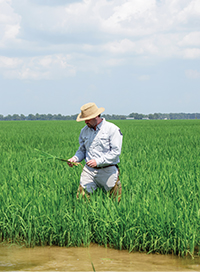 The adage that time is money has convinced a handful of adventurous Mid-South rice producers to convert acreage to a row rice production system.
The adage that time is money has convinced a handful of adventurous Mid-South rice producers to convert acreage to a row rice production system.
This year’s challenging early season field conditions led to the decision to plant row rice, says Johnathon Morris, retailer-consultant with Tri County Coop in Brinkley, Arkansas. “Because of the excessive rainfall we received, field prep was essentially zero going into planting season,” he says.
Traditional rice acreage is often converted to row rice because the system saves time and labor. “In fields requiring contour levees, row rice production can save a grower substantial time by negating the need to build levees,” Morris says.
Although row rice offers front-end savings, eliminating the permanent flood creates new challenges, including nitrogen management and weed control.
Controlled by the permanent flood, weeds such as Palmer amaranth (pigweed) are rarely a problem in conventional rice production. That changes in a row rice production system.
“With row rice, you are completely changing the whole environment of rice production,” Morris says. “The flood pretty well handles our pigweed population. Without that flood, you’re looking at heavier weed pressure and additional grass pressure. It’s a challenge until you can get the rice to canopy.”
For row rice weed control, Morris recommends starting with multiple applications of residual herbicides followed by a tank-mix application including Loyant® herbicide before irrigation begins.
“Loyant helps a lot with the added weed pressure that comes with the row rice system. There are fields where pigweed control would be impossible without Loyant,” Morris adds.
With the addition of Loyant with Rinskor™ active to a row rice production system, control of broadleaf weeds, sedges and grasses is improved.
The More You Grow
Find expert insights on agronomics, crop protection, farm operations and more.